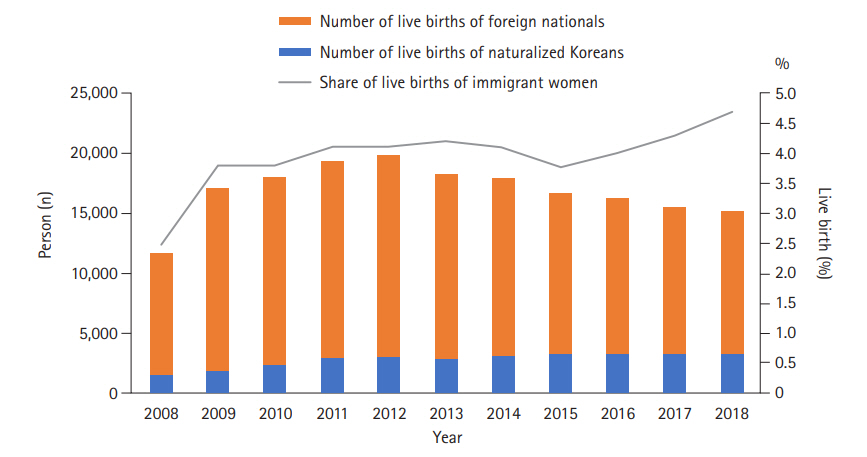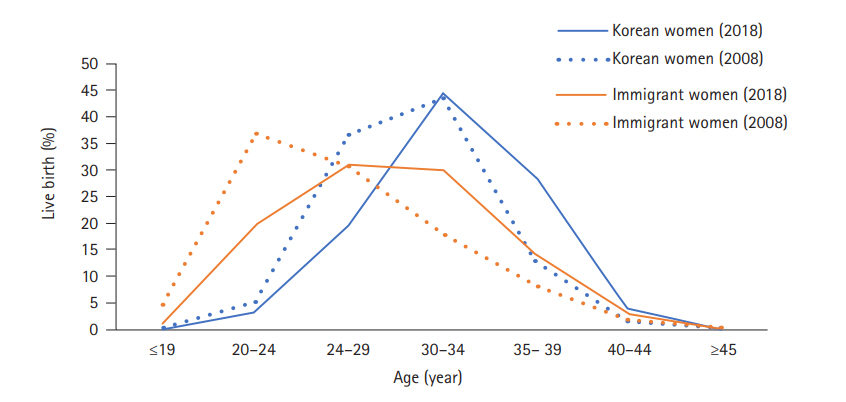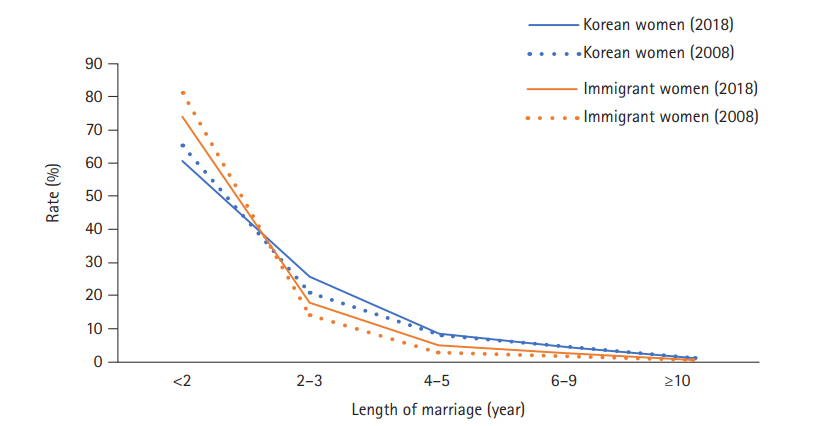Korean J Women Health Nurs.
2021 Mar;27(1):40-48. 10.4069/kjwhn.2021.03.15.
Comparison of the number of live births, maternal age at childbirth, and weight of live births between Korean women and immigrant women in 2018
- Affiliations
-
- 1College of Nursing, Daegu Catholic University, Daegu, Korea
- 2Vital Statistics Division, Statistics Korea, Daejeon, Korea
- 3School of Nursing and Research Institute in Nursing Science, Hallym University, Chuncheon, Korea
- 4Department of Nursing, Daegu Haany University, Daegu, Korea
- 5College of Nursing, Ewha Womans University, Seoul, Korea
- KMID: 2514703
- DOI: http://doi.org/10.4069/kjwhn.2021.03.15
Abstract
- Purpose
This study compared maternal age at childbirth, the number of live births, and the weight of live births between Korean women and immigrant women using statistical data from the Republic of Korea for 2018.
Methods
The analysis was conducted using data from the Microdata Integrated Service of Statistics Korea (https://mdis.kostat.go.kr/index.do).
Results
Korean women and immigrant women showed a higher age at childbirth in 2018 than in 2008. The percentage of newborns of Korean women with a birth weight of less than 2.5 kg increased slightly for 3 consecutive years from 2016 to 2018, whereas for immigrant women, this percentage increased in 2017 compared to 2016 and then decreased again in 2018. Very low birth weight (less than 1.5 kg) became more common among immigrant women from 2016 to 2018. Birth at a gestational age of fewer than 37 weeks increased both among Korean and immigrant women from 2016 to 2018. In both groups, the percentage of women who had their first child within their first 2 years of marriage decreased from 2008 to 2018.
Conclusion
Immigrant women had higher birth rates than Korean women, while both groups showed an increasing trend in premature birth. Greater attention should be paid to the pregnancy and birth needs of immigrant women, and steps are needed to ensure health equity and access in order to prevent premature births. It is also necessary to identify factors that affect preterm birth and birth of very low birth weight infants among immigrant women in the future.
Figure
Cited by 1 articles
-
Comparison of infant mortality and associated factors between Korean and immigrant women in Korea: an 11-year longitudinal study
Kyung Won Kim, Ju-Hee Nho, Sooyoung Kim, Byeongje Park, Sanghee Park, Bobae Kang, Sun-Hee Kim
Korean J Women Health Nurs. 2021;27(4):286-296. doi: 10.4069/kjwhn.2021.12.12.2.
Reference
-
References
1. Statistics Korea. The census of population trend: number of population dynamics and trends in dynamics [Internet]. Daejeon: Author; 2020 [cited 2020 Dec 1]. Available from: https://kosis.kr/statHtml/statHtml.do?orgId=101&tblId=DT_1B8000F&vw_cd=MT_ZTITLE&list_id=A2_6&seqNo=&lang_mode=ko&language=kor&obj_var_id=&itm_id=&conn_path=MT_ZTITLE.2. Statistics Korea. The census of population trend: average first marriage age by city and province [Internet]. Daejeon: Author; 2020 [cited 2020 Nov 4]. Available from: https://kosis.kr/statHtml/statHtml.do?orgId=101&tblId=DT_1B83A05&vw_cd=&list_id=&scrId=&seqNo=&lang_mode=ko&obj_var_id=&itm_id=&conn_path=E1.3. Statistics Korea. The census of population trend: average maternal age by city or province and birth order [Internet]. Daejeon: Author; 2020 [cited 2020 Nov 2]. Available from: https://kosis.kr/statHtml/statHtml.do?orgId=101&tblId=DT_1B81A20&vw_cd=MT_ZTITLE&list_id=A21&seqNo=&lang_mode=ko&language=kor&obj_var_id=&itm_id=&conn_path=MT_ZTITLE.4. Kortekaas JC, Kazemier BM, Keulen JK, Bruinsma A, Mol BW, Vandenbussche F, et al. Risk of adverse pregnancy outcomes of late- and postterm pregnancies in advanced maternal age: a national cohort study. Acta Obstet Gynecol Scand. 2020; 99(8):1022–1030. https://doi.org/10.1111/aogs.13828.
Article5. Statistics Korea. The census of population trend: Korean husband’s marriage type/foreign wife’s marriage by nationality [Internet]. Daejeon: Author; 2020 [cited 2020 Nov 4]. Available from: https://kosis.kr/statHtml/statHtml.do?orgId=101&tblId=DT_1B83A31&vw_cd=MT_ZTITLE&list_id=A23_4&seqNo=&lang_mode=ko&language=kor&obj_var_id=&itm_id=&conn_path=MT_ZTITLE.6. Statistics Korea. The census of population trend: number of marriages (province/city/country/gu) [Internet]. Daejeon: Author; 2020 [cited 2020 Nov 3]. Available from: https://kosis.kr/statHtml/statHtml.do?orgId=101&tblId=INH_1B83A35&vw_cd=MT_GTITLE01&list_id=102&seqNo=&lang_mode=ko&language=kor&obj_var_id=&itm_id=&conn_path=MT_GTITLE0.7. Statistics Korea. Statistics of newlyweds: number of newlyweds in multicultural families by marriage age [Internet]. Daejeon: Author; 2019 [cited 2020 Nov 3]. Available from: https://kosis.kr/statHtml/statHtml.do?orgId=101&tblId=DT_1NW2009&vw_cd=MT_ZTITLE&list_id=D2_NW_20&seqNo=&lang_mode=ko&language=kor&obj_var_id=&itm_id=&conn_path=MT_ZTITLE.8. Statistics Korea. Statistics on multicultural population dynamics in 2019 [Internet]. Daejeon: Author; 2020 [cited 2020 Nov 3]. Available from: http://kostat.go.kr/portal/korea/kor_nw/1/1/index.board?bmode=read&aSeq=385962.9. Shin YJ, Lee K. A status diagnosis and improvement of women marriage immigrant policy. Korea Crim Intell Rev. 2019; 5(2):63–84. https://doi.org/10.33563/KSCIA.2019.5.2.4.
Article10. Kim JY, Min HY, Yang MJ, Kim BY. Pregnancy of married immigrant women in Korea: a qualitative meta-synthesis. J Qual Res. 2019; 20(2):79–89. https://doi.org/10.22284/qr.2019.20.2.79.
Article11. Khanlou N, Haque N, Skinner A, Mantini A, Kurtz Landy C. Scoping review on maternal health among immigrant and refugee women in Canada: prenatal, intrapartum, and postnatal care. J Pregnancy. 2017; 2017:8783294. https://doi.org/10.1155/2017/8783294.
Article12. Jeong GH, Koh HJ, Kim KS, Kim SH, Kim JH, Park HS, et al. A survey on health management of during pregnancy, childbirth, and the postpartum of immigrant women in a multi-cultural family. Korean J Women Health Nurs. 2009; 15(4):261–269. https://doi.org/10.4069/kjwhn.2009.15.4.261.
Article13. Ministry of Gender Equality and Family. The 2015 national survey on multicultural family [Internet]. Seoul: Author; 2016 [cited 2020 Nov 4]. Available from: http://www.mogef.go.kr/nw/rpd/nw_rpd_s001d.do?mid=news405&bbtSn=702320.14. Park K, Moon H, Lee ES. Study on the changes of prenatal and labor characteristics of married immigrant women referred to a university hospital for 10 years. J Korea Acad Industr Coop Soc. 2018; 19(3):317–324. https://doi.org/https://doi.org/10.5762/KAIS.2018.19.3.317.
Article15. Statistics Korea. The census of population trend: annual data of birth. [Internet]. Daejeon: Author; 2020 [cited 2020 Nov]. Available from: https://mdis.kostat.go.kr/index.do.16. Kowaleski J. State definitions and reporting requirements for live births, fetal deaths, and induced terminations of pregnancy (1997 revision) [Internet]. Hyattsville, MD: National Center for Health Statistics; 1997 [cited 2021 Jan 1]. Available from: https://www.cdc.gov/nchs/products/other/miscpub/statereq.htm.17. Ministry of Justice. Korea immigration service statistics 2019 [Internet]. Gwacheon: Author; 2020 [cited 2020 Nov 4]. Available from: https://www.immigration.go.kr/immigration/1570/subview.do?enc=Zm5jdDF8QEB8JTJGYmJzJTJGaW1taWdyYXRpb24lMkYyMjglMkY1Mjc3MTIlMkZhcnRjbFZpZXcuZG8lM0ZwYXNzd29yZCUzRCUyNnJnc0JnbmRlU3RyJTNEJTI2YmJzQ2xTZXElM0QlMjZyZ3NFbmRkZVN0ciUzRCUyNmlzVmlld01pbmUlM0RmYWxzZSUyNnBhZ2UlM0QxJTI2YmJzT3BlbldyZFNlcSUzRCUyNnNyY2hDb2x1bW4lM0QlMjZzcmNoV3JkJTNEJTI2.18. Jeong GH, Kim KW, Baik S. Comparison of needs for pregnancy and postpartum adaptation of Chinese immigrant women and Vietnamese immigrant women in South Korea. Korean J Women Health Nurs. 2019; 25(1):19–30. https://doi.org/10.4069/kjwhn.2019.25.1.19.
Article19. Kim KW, Baik SH, Jeong GH. Development and evaluation of multilingual education materials to promote immigrant women’s adaptation to pregnancy. Korean J Women Health Nurs. 2014; 20(4):235–245. https://doi.org/10.4069/kjwhn.2014.20.4.235.
Article20. Racape J, Schoenborn C, Sow M, Alexander S, De Spiegelaere M. Are all immigrant mothers really at risk of low birth weight and perinatal mortality? The crucial role of socio-economic status. BMC Pregnancy Childbirth. 2016; 16:75. https://doi.org/10.1186/s12884-016-0860-9.
Article21. Cunningham FG, Leveno KJ, Bloom SL, Dashe JS, Hoffman BL, Casey BM, et al. Williams obstetrics, 25th ed. New York: McGraw-Hill Education;2018.22. Zavadenko NN, Davydova LA. [Neurological and neurodevelopmental disorders in preterm-born children (with extremely low, very low or low body weight)]. Zh Nevrol Psikhiatr Im S S Korsakova. 2019; 119(12):12–19. https://doi.org/10.17116/jnevro201911912112. Russian.
Article23. Neri E, Agostini F, Baldoni F, Facondini E, Biasini A, Monti F. Preterm infant development, maternal distress and sensitivity: the influence of severity of birth weight. Early Hum Dev. 2017; 106-107:19–24. https://doi.org/10.1016/j.earlhumdev.2017.01.011.
Article24. Schuetz Haemmerli N, Lemola S, Holditch-Davis D, Cignacco E. Comparative evaluation of parental stress experiences up to 2 to 3 years after preterm and term birth. Adv Neonatal Care. 2020; 20(4):301–313. https://doi.org/10.1097/ANC.0000000000000714.
Article25. Lee SL. Determinants of birth outcomes: paternal age effects and life-span approach. J Health Soc Sci. 2014; (35):175–209.
- Full Text Links
- Actions
-
Cited
- CITED
-
- Close
- Share
- Similar articles
-
- Trends and Changes of Maternal Age at Live Birth and Related Statistics in Korea (1981-2019)
- Changes of Maternal Age Distribution in Live Births and Incidence of Low Birth Weight Infants in Advanced Maternal Age Group in Korea
- Recent Trends in the Incidence of Multiple Births and Its Consequences on Perinatal Problems in Korea
- Maternal, infant, and perinatal mortality statistics and trends in Korea between 2018 and 2020
- Trends, statistics, and policy recommendations on maternal, fetal, and infant mortality before and after COVID-19: a review of the past decade (2012-2022) based on national health information data




